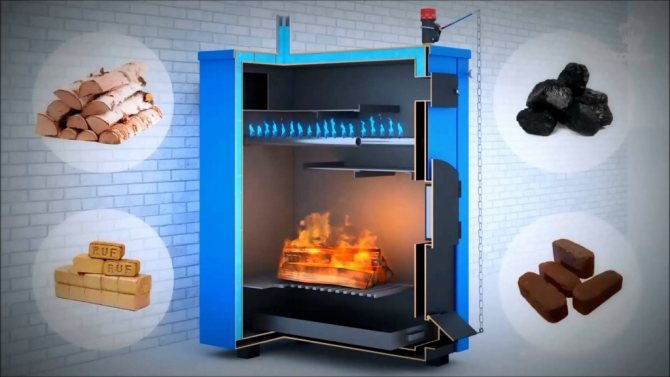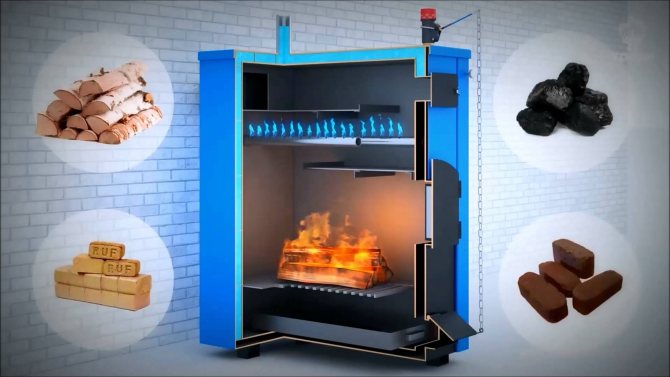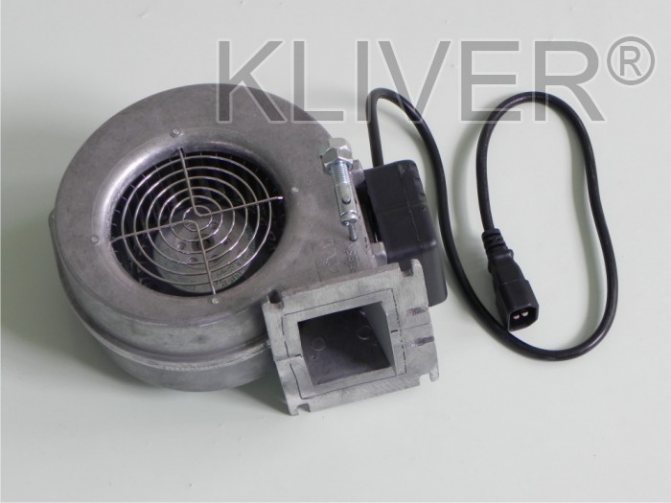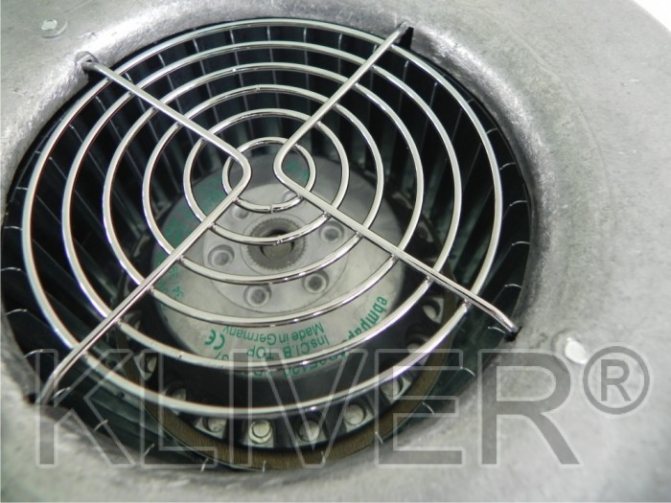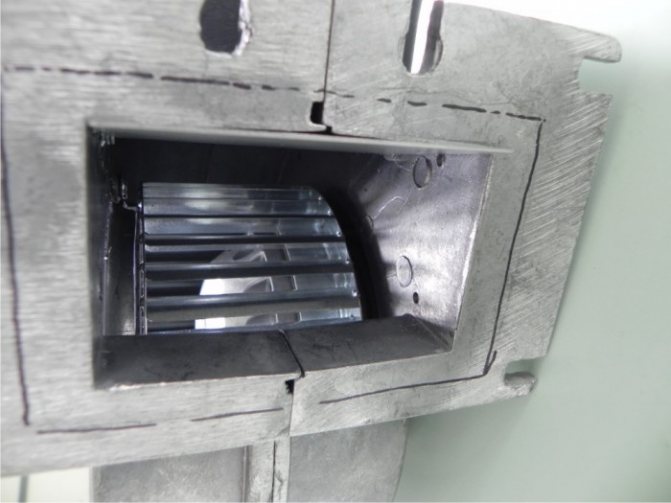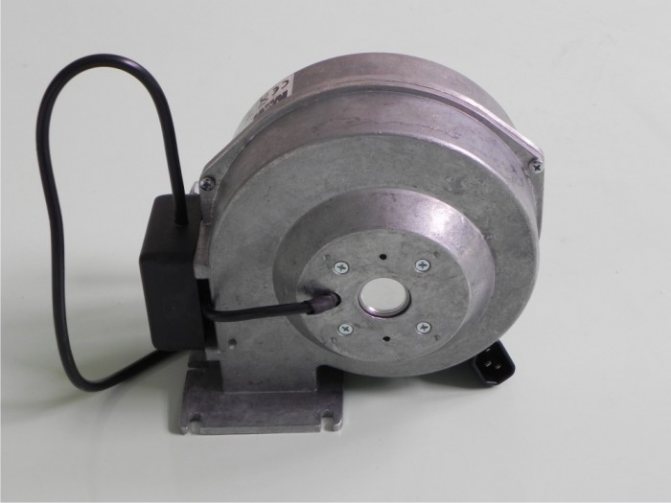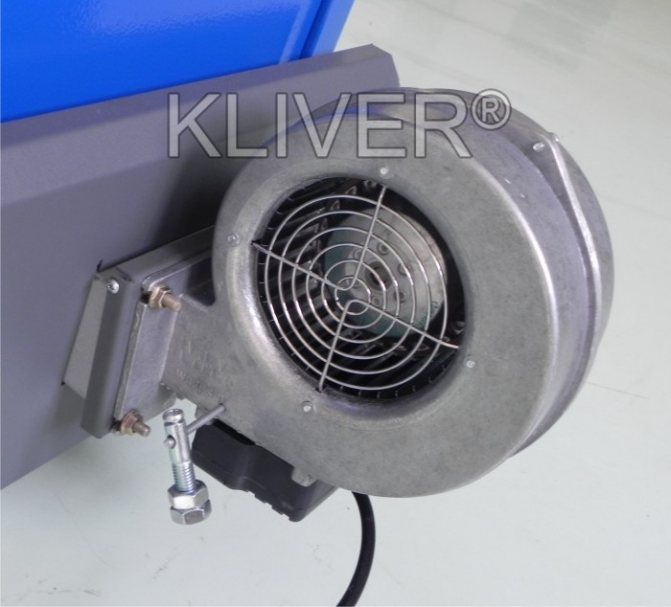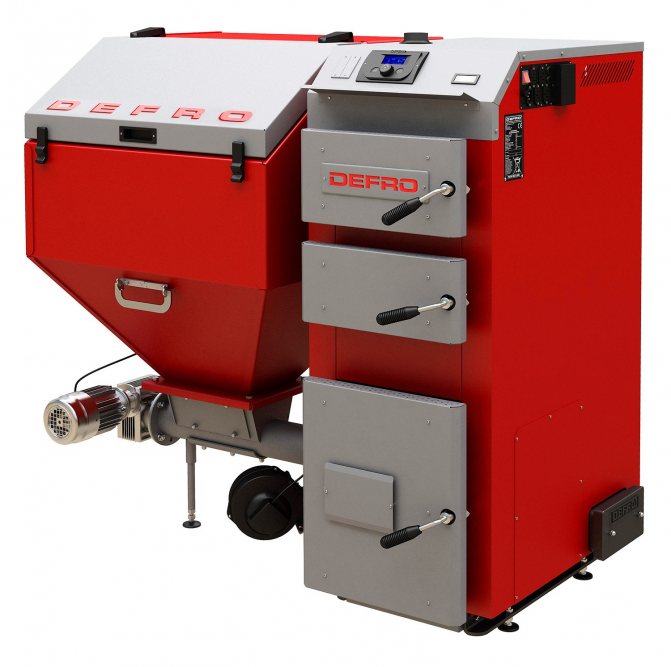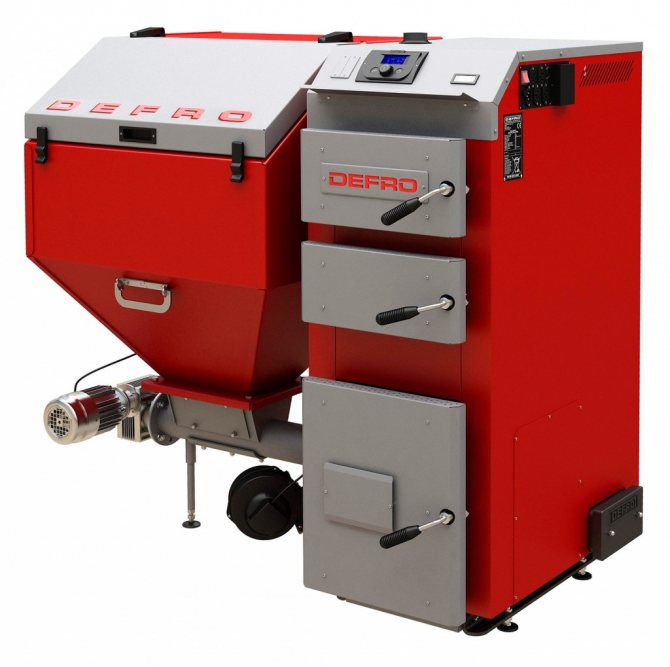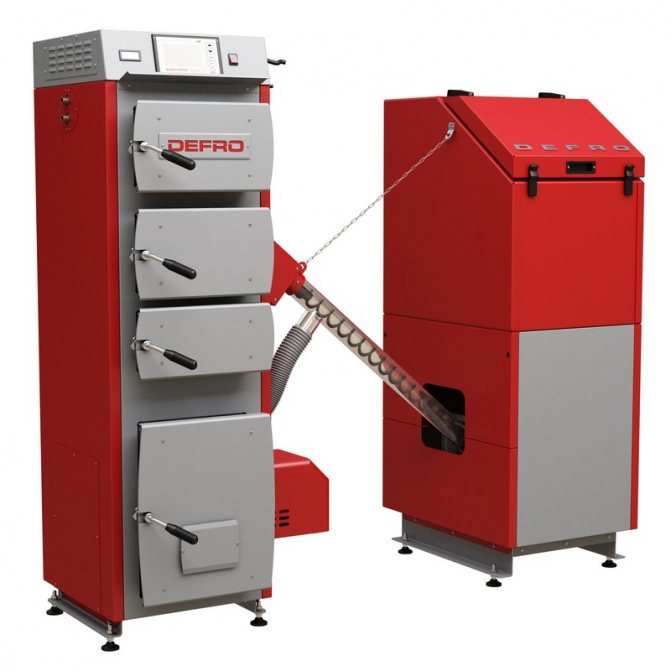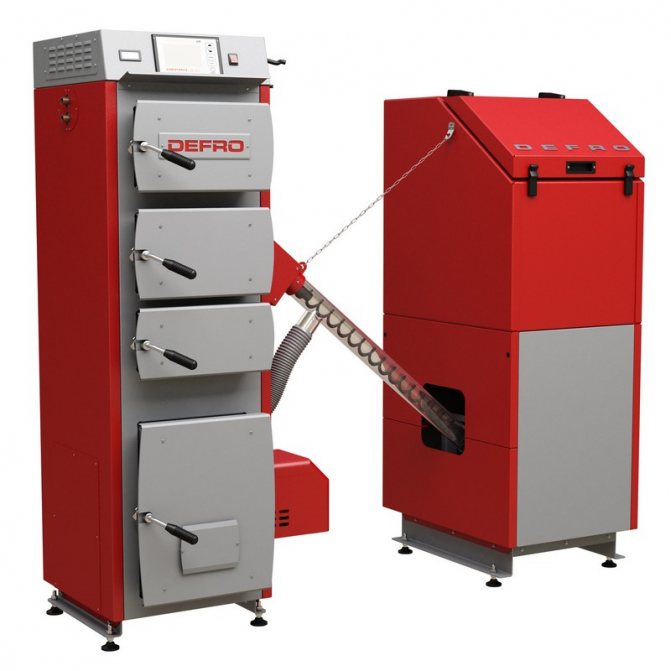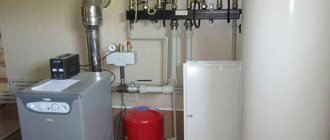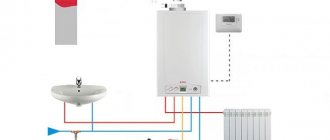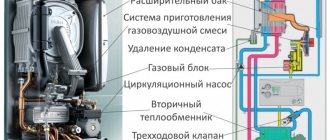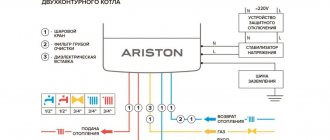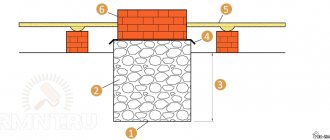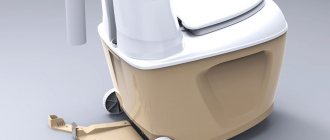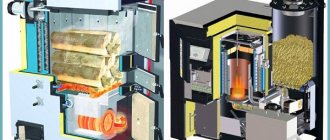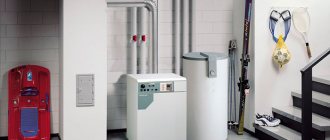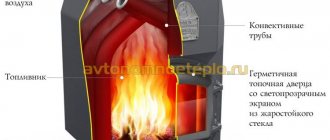Briefly about pyrolysis combustion
The pyrolysis process is the slow decomposition of carbon fuels, which occurs under the influence of high temperatures with a lack of oxygen. Combustible gas or liquid fuel is obtained at the exit, depending on the feedstock and the conditions of the chemical reaction.
Pyrolysis heating boilers produce and burn exactly gas, hence the second name - gas generating or gasifying. Initial raw materials - dry firewood, coal, fuel briquettes.
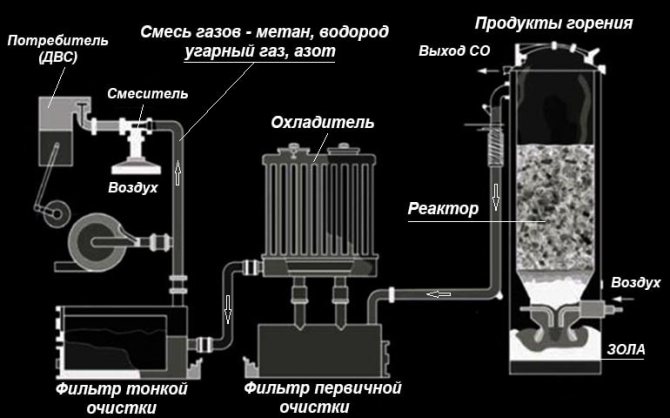
Diagram of a gas generator plant that produces fuel for an internal combustion engine
Reference. A wide variety of solid fuels containing hydrocarbon compounds are used for pyrolysis combustion. An example is the production of liquid fuel from old car tires or the incineration of waste in industrial gas-fired ovens.
How wood pyrolysis occurs:
- A certain volume of chopped wood or sawdust is loaded into a closed tank (reactor).
- The metal vessel is heated from the outside up to 500 ... 900 ° C, air is supplied through the tuyeres (blowing holes) limitedly.
- Wood smolders and decomposes into its constituents - hydrogen, methane, carbon monoxide, water vapor, carbon dioxide. At the end of the reaction, some ash remains at the bottom.
- The resulting gas mixture is cooled, cleaned, and then pumped into cylinders for further use.
Before loading into the gas generator, the wood is dried. Otherwise, the heating energy will be spent on the evaporation of water, the pyrolysis reaction will slow down greatly, and we will get a bunch of water vapor at the exit.
Note that any process of burning solid fuel is accompanied by the release of wood gas, even in a fire (see the photo). Pyrolysis is described in more detail in our other publication.
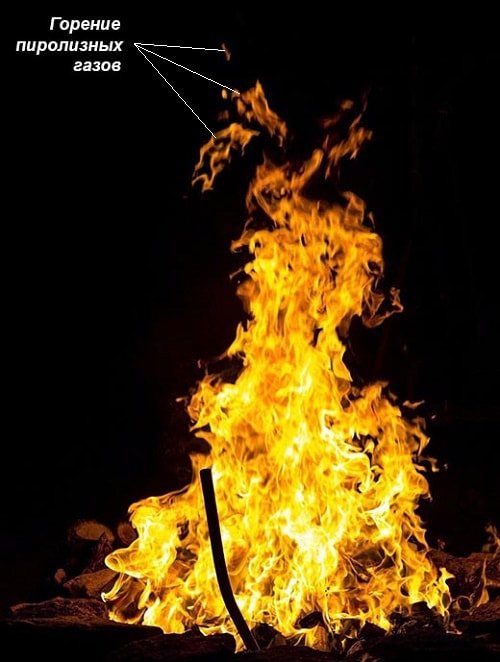

Types of pellet boilers
Equipment is classified according to two criteria - fuel supply and burner type. There are three options for loading pellets into the burner:
- mechanical,
- semi-automatic,
- auto.
Mechanical fuel supply implies constant support of combustion in the firebox by the owner, including at night. Instead of enjoying a warm evening with the family, the homeowner acts as a stoker.
Semi-automatic feeding looks more advantageous - only the power of the boiler is manually set, and the pellets are loaded into the furnace without human intervention. This is the best value for money.
Pellet boilers with automatic fuel supply are a little more expensive. Unlike previous options, specialists should be invited to install them. Setting the boiler to the desired mode takes no more than a couple of minutes, after which the boiler does all the work to maintain the specified parameters and load the pellets into the furnace in automatic mode.
Pellet boiler burners are:
- torches,
- fireplace,
- volumetric combustion.
Flare burners are used in small boilers with small furnaces. They are easy to configure, easy to operate, and reliable enough. Their disadvantage is the pronounced direction of the flame on one of the walls of the boiler, which, as a result, is constantly subjected to local heating. In addition, flare burners are sensitive to the quality of the fuel - they hardly support the flame generated by the second-rate fuel.
Fireplace burners are distinguished by safety, low noise level during operation, however, they also react to the quality of solid fuel. They also have little adjustment options.
These disadvantages are devoid of volumetric combustion devices, which, due to their high power, are often used for industrial purposes.They work without problems on low quality pellets. The only drawback of these burners is that they add weight to the equipment.
Operating rules
To get good heat transfer from a gas generator heater with minimal fuel consumption, manufacturers recommend adhering to the following rules:
- use only dry wood, permissible moisture content 12 ... 20%;
- when installing and piping the boiler, it is imperative to use a three-way mixing valve or a complex Laddomat-21 device to maintain the return temperature at 65 ° C;
- operating temperature of the heating agent at the supply - 80 ... 90 ° C;
- the heat generator must operate at a power close to the maximum; it is impossible to operate the unit for a long time in the mode of low productivity (less than 50%);
- it is very advisable to drown with large logs, but not round logs;
- together with pyrolysis boilers, it is strongly recommended to use a buffer tank, which will accumulate excess thermal energy;
- the requirement for the minimum volume of the heat accumulator is 25 liters for each kilowatt of heater power.
Explanation. If a cold coolant with a temperature below 65 degrees goes into the boiler tank, then in the process of fuel gasification in the primary chamber condensate and tar will form. Read more about the correct piping in a separate manual on connecting TT boilers.
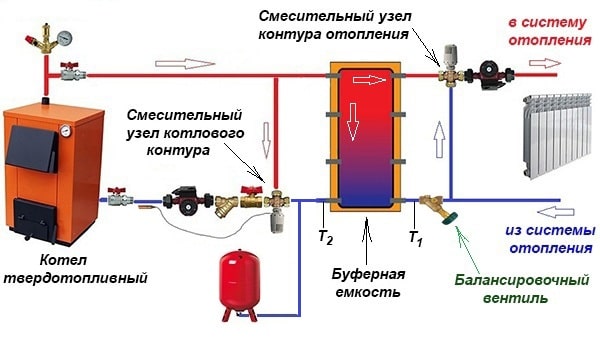

The heating agent supply to the boiler must be regulated by a three-way valve. After the buffer tank, another mixing unit is installed to lower the water temperature
The use of the buffer tank is due to the effective operating mode of the boiler - intensive combustion, the outlet temperature is 80 ... 90 degrees. It is under such conditions that a high efficiency of 86–87% is achieved. It is impossible to "choke" the heat generator through the air, the combustion efficiency will decrease to 40-50%, like in a homemade stove-stove.
Solid fuel boilers, into the furnace of which secondary air is supplied
In traditional boilers with a natural process of burning fuel, the process of controlling the power of the device is carried out using a special damper, that is, by reducing the amount of supplied air. The disadvantage of such a control system is deservedly considered that a large number of substances that are applicable as fuel for a boiler volatilize along with the combustion products.
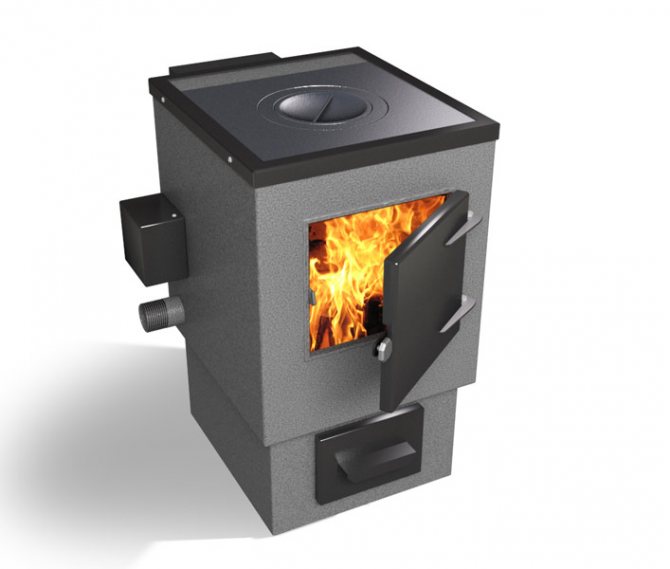

It turns out that the consumption of firewood increases, while the usefulness of the boiler, on the contrary, decreases. In the boilers under consideration, a natural process of fuel combustion occurs, that is, the entire batch of firewood placed in the furnace burns simultaneously, however, secondary air also enters the combustion chamber, which ensures not only the combustion of firewood, but also combustible substances and gases, which were discussed several above. The decision to supply secondary air to the combustion chamber of such boilers made them more economical and therefore more profitable.
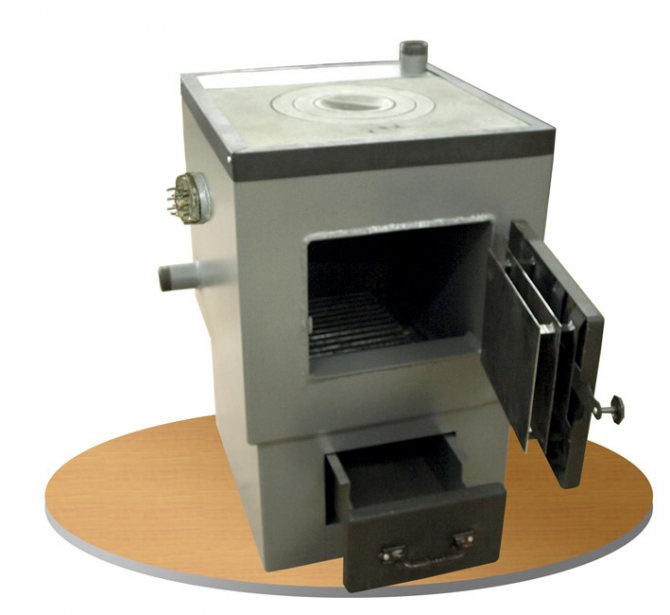

Thanks to this approach, the efficiency of the boiler increases significantly, but other operating parameters remain similar to those of other boilers. Such boilers are also called pyrolysis boilers by most sellers and selling organizations, however, such a statement is constantly subjected to fair criticism. The described boilers are pseudo-pyrolysis, and the talk that such devices are pyrolysis is an unfair marketing ploy.
The real benefits of pyrolysis heaters
Let's list the advantages of gasifying boilers declared by sellers, and then we will weed out frank stories:
- pyrolysis heat sources are full-fledged gas generators emitting combustible synthesis gas;
- the units are very economical and environmentally friendly due to their high efficiency;
- the boilers completely burns coal and firewood, with practically no residue;
- burning time - over 10 hours (the most modest figure is 8 hours).
Note.Advertisers and not too conscientious manufacturers always compare gas generating units with conventional direct combustion boilers, "forgetting" about equally efficient pellet heaters. But even this comparison is not very winning.
The first statement is too bold. Let's remember: intense pyrolysis starts from strong heating and a lack of oxygen, but what happens in the boiler? The fan blows air into the firebox in excess, there is no smoldering. Synthesis gas, of course, is released, but direct fuel combustion is also present.
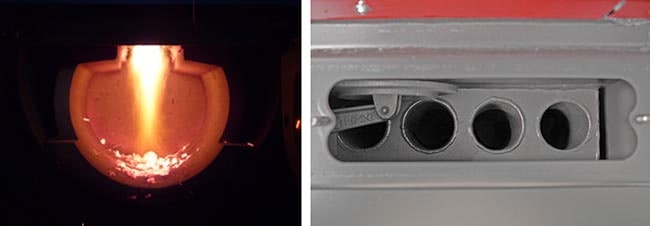

On the left is a flame torch in the afterburner compartment during boiler operation, on the right is a fire-tube heat exchanger (top view)
Let's take a look at the rest of the benefits:
- The statement about economy and environmental friendliness is not a fairy tale. Due to the decent efficiency, the boiler better assimilates the energy of the fuel and emits much less toxic compounds - nitrogen oxide and carbon monoxide - into the atmosphere. On condition 1: the recommendations on the operating mode and the moisture content of the firewood are fully observed.
- The reasons for a more complete combustion are dry wood and forced air injection. If you put sawdust briquettes or dry acacia in a traditional turbocharged boiler, the ash residue will also be zero. A lot of light ash is simply blown out by a fan into the chimney. This means that this fact is not an advantage.
- The burning time depends on 2 factors: efficiency and capacity of the fuel compartment. In terms of efficiency, solid fuel boilers lose to pyrolysis boilers by 10%, this is a small increase in the duration of operation. The main factor is the volume of the combustion chamber, if it reaches 80 liters or more, firewood will burn out in 6-8 hours.
Reference. The Czech manufacturer Atmos describes the advantages of its heat generators (literally): a large fuel bunker - a long burning time. Hence the conclusion: the statement about the duration of the work is true, only the reason is different - the capacity of the furnace, and not the fact of generating wood gas.
Also, a lot of fables are told about the economical mode of smoldering, which is simply absent in pyrolysis units. It is written in the operating instructions "Atmos DC15E" - a decrease in flame intensity leads to a decrease in efficiency and an increase in fuel consumption.
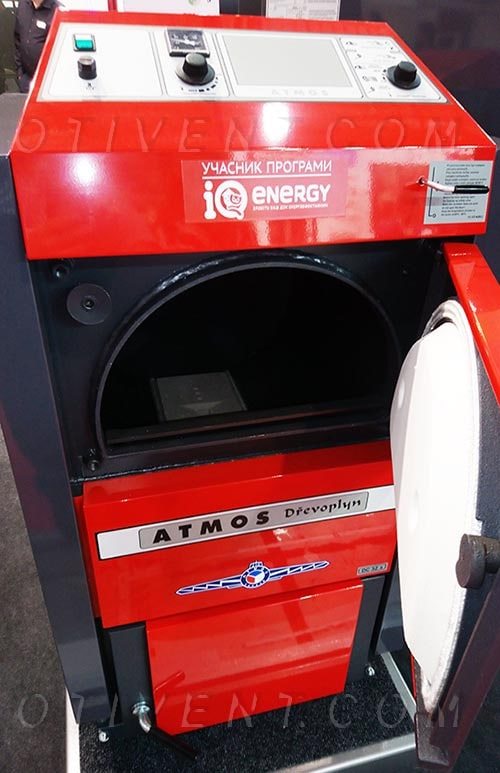

The newest heat generator "Atmos" of pyrolysis type at the exhibition "Aquatherm-2019"
Naturally burning solid fuel boilers
Boilers of this type differ from their counterparts in that all the firewood that was placed in the furnace burns simultaneously, that is, the process of burning solid fuel, in this case, firewood, occurs naturally.
The advantages of boilers of this type are traditionally referred to as simple design and low cost of the product. Such a boiler is indulgent to the quality of firewood and does not cause difficulties in the maintenance process, which can also be attributed to the asset of the device.
The operator of such a boiler can control the power of the device, but this indicator can fluctuate between 60 and 100% efficiency, the specific figure depends on how intense the combustion is. The combustion intensity is regulated by means of a special damper, which limits the ingress of air into the boiler. Together with the power, the efficiency of the apparatus inevitably decreases.
Practice shows that the maximum efficiency that such boilers can boast is 80%. Speaking about the disadvantages of solid fuel boilers with a natural type of fuel combustion, it is customary to remember that the process of fuel combustion occurs as soon as possible. As a rule, one batch of firewood placed in the boiler is enough for no more than 4 hours.
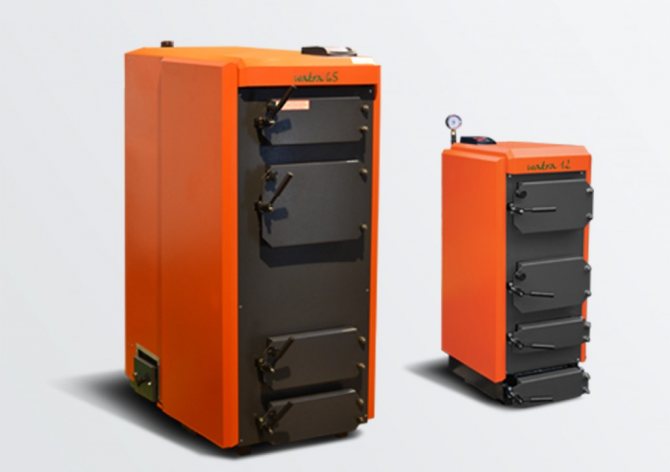

Significant disadvantages of boilers
If you visit any online store of heating units and ask how much pyrolysis heat generators cost, you will immediately see their main drawback.Not the most expensive Russian boiler "Suvorov M" K-20 (20 kW) will cost 1320 cu. That is, and the ATMOS DC 20 GS, identical in power, is 2950 cu. e. For comparison: the price of an expensive traditional heater Buderus Logano S131-22 H is $ 1010. e.
Let's designate other disadvantages of gasifying heat sources:
- 2 chambers, brick or ceramic lining plus a water jacket in the lower part of the body - the above design solutions significantly increase the weight and dimensions of the units;
- high requirements for fuel quality;
- a coolant with a temperature of 80 ° C is rarely used when heating private houses, which means that you cannot do without an expensive heat accumulator + piping elements;
- ceramic parts of the lining do not last forever - the nozzle may crack from overheating and will have to be replaced.
I must say, pyrolysis boilers attract home craftsmen. But making such a unit with your own hands is very difficult, you need experience and investment in the purchase of materials. It is not possible to make a heater for free. Much easier to weld a conventional or mine boiler.
Note. Judging by the reviews of the owners of the boilers on the thematic forums, it is still possible to use raw firewood. The algorithm is as follows: the unit is melted and warmed up with dry logs, then damp wood is thrown up. But the share of such fuel should not exceed 30%, otherwise soot and soot will go. Let's hear the expert's opinion on the video:
Solid fuel boilers in the air heating system
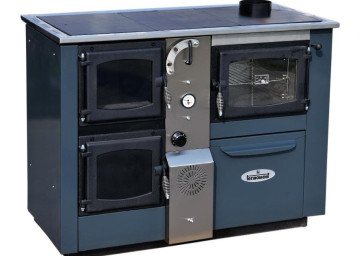

All heating systems need a heat source and the boiler solves this problem.
The simplest and cheapest option of all heating units is a solid fuel heating boiler.
Heating types
- Water heating is a system of pipes and radiators. The heat carrier (water or antifreeze) circulates in a closed loop, warming up in the boiler heat exchanger.
- Air heating consists of one or more hot water boilers and a duct system.
To find out how to make a gas boiler with your own hands, read the article.
You can read about the creation of climatic complexes based on gas boilers by the link -
Also read useful information about boilers for heating greenhouses.
Comparison of water and air heating:
- The cost of air heating of a private house is much lower than water heating.
- The design and operation of air heating of a room is simpler than water heating.
- Due to the low temperature inertia, air heating is able to instantly warm up the room. However, after turning off the heating, the same property of low inertia will allow the room to cool down faster than when using water heating.
- Installation of an air heating system is simpler than water heating.
- In the summertime, the air heating system can be used as ventilation.
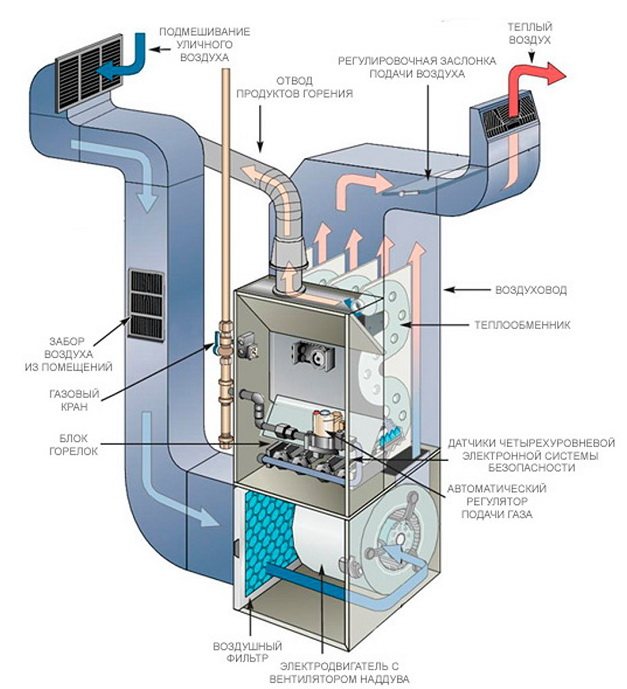

The disadvantage of air heating is the large diameter of the air ducts, which makes it difficult to route them through walls or ceilings. The main element of a solid fuel boiler is a firebox (combustion chamber) and a heat exchanger.
Combustion chamber device
To load fuel, the furnace is equipped with a metal hatch. To remove ash, a grate is installed in the combustion chamber - and combustion takes place on it. In the lower part of the unit there are containers for collecting ash, which must be emptied periodically.
Combustion can take place in different ways and one of the most efficient ways to burn solid fuels is the principle of gasification. Gas generating (pyrolysis) boilers work on this principle.
Gas generator boiler furnace
The furnace of such boilers is divided into 2 chambers, one of which creates a high temperature, but combustion does not occur due to a lack of oxygen. Under such conditions, the solid fuel decomposes into volatiles, which are burned as gas fuel in the second chamber.
Air heating boiler heat exchanger
Air passes between the boiler body and its firebox - this is the heat exchanger.The outer walls of the firebox are constantly washed by air currents. Heating surfaces are also located in the boiler flue.
Primary and secondary air
To achieve greater efficiency of the boilers, primary and secondary air is supplied to their furnace:
- Primary air is clean indoor or outdoor air. To reduce heat losses, it is preheated and then fed into the furnace.
- Secondary air is a mixture of air and solid fuel combustion products. As a rule, the fuel is not burned 100%, so there are still flammable substances in the flue gases. Their advantage is that they already have a high temperature and their "afterburning" does not require costs, but significantly increases the efficiency. Secondary air is taken from the upper part of the flue, and its supply is regulated by a damper.
The intensity of fuel combustion is adjusted by opening / closing the air supply damper to the boiler furnace. It can be done manually or automatically.
Fans in solid fuel boilers
Sufficient oxygen is required for complete combustion of the fuel. The air supply function can be performed by a blower fan.
To create forced draft, smoke exhausters are installed in the boiler - fans that draw out the combustion products from the boiler.
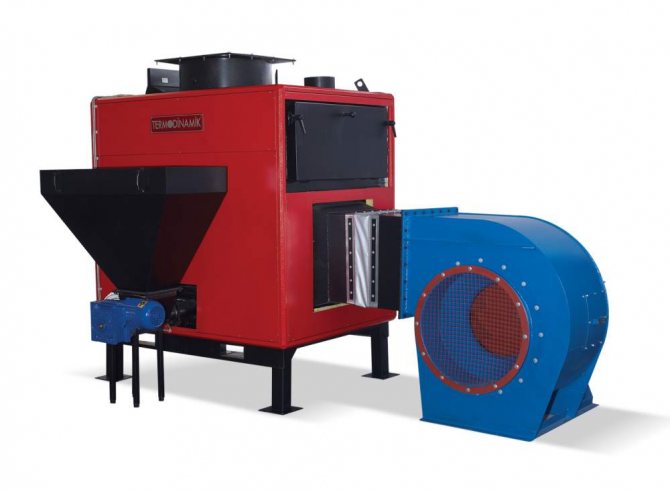

Air heating automation
There are various types of boilers for solid fuel combustion, many of which are provided with automatic systems: ignition, combustion intensity, fuel loading. They are able to maintain a given temperature regime.
The main elements of automation:
- Combustion temperature sensor.
- Room air temperature sensor.
- Automatic air supply control system.
Read about one-pipe and two-pipe heating systems here.
Find out how to make a heating boiler for a bath with your own hands -
Also read about the leading manufacturers of domestic gas heating boilers.
Heat generators brands
| Lechma PP-190 Lux | Bourgeois-K | Professor Butakov | |
| Manufacturer | Poland | Russia | Russia |
| Power | 14 | 35-100 | 9-25 |
| Fuel consumption (kg / h.) | 3 | ||
| Burning time 1 load | 6 h | 5-12 hours | Long-term |
| Efficiency (%) | 75 | 82-92 | 85 |
| Type of firebox | Traditional | ||
| Fuel | Firewood, briquettes | Wood, coal, briquettes | Firewood |
| Material | Steel | ||
| Price, rub.) | 80 000 | 240 000 | 17000-35000 |
Air heating solid fuel units are efficient in operation, and most importantly, they are safe and affordable.
Conclusions and recommendations for selection
It makes sense to choose pyrolysis boilers from all existing boilers in this situation:
- you are willing to pay for efficiency and environmental conservation;
- the budget allows you to purchase a heater and heat accumulator of the required volume;
- there is enough space for equipment in the boiler room;
- there is an opportunity to harvest high-quality firewood, buy briquettes or dry freshly cut wood.
The heat generator model is selected in terms of power and functionality. How to choose the right wood-fired heat source for your home, read our instructions.
Initially, pyrolysis household boilers are designed to install a storage tank and use good fuel. This is a Western European practice where solid fuel units cannot be operated without a buffer tank.
Our incomes are not so high, which is why homeowners save on everything - equipment, fuel, method of combustion. Hence the conclusion: at the moment, gas generators are incompatible with the needs and costs of most homeowners, because they will not be able to be properly operated.
What is pyrolysis?
The operation of a gas-generating boiler is based on the principle of pyrolysis combustion (or dry distillation) of fuel, the essence of which is that under the influence of high temperature and in conditions of a lack of oxygen, dry wood decomposes into a volatile part - the so-called pyrolysis gas and solid residue - charcoal ( coke).
Wood pyrolysis is carried out at a temperature of 200 - 800 ° C. Moreover, this process is exothermic, that is, going with the release of heat, due to which, by the way, the heating and drying of the fuel in the boiler is improved, and the air entering the combustion zone is heated.
The mixing of oxygen in the air with the released pyrolysis gas at a high temperature causes the combustion process of the latter, which is used later to obtain thermal energy. It should be noted that the pyrolysis gas interacts with active carbon during combustion, as a result of which the flue gases at the outlet of the boiler practically do not contain harmful impurities, being, for the most part, a mixture of carbon dioxide and water vapor. And even such a boiler will emit CO2 into the atmosphere up to 3 times less than an ordinary wood-burning and, moreover, a coal boiler.
In the process of pyrolysis combustion, a minimum amount of soot and ash is formed, therefore the boiler needs to be cleaned less often than a conventional one.
Bottom horizontal combustion heating boiler
In a solid fuel boiler with a thrust directed horizontally, the process of natural combustion of fuel takes place in the lower layer of the firewood
As can be seen from the above figure, in a boiler with horizontal fuel combustion, combustion occurs near the grate, the resulting flue gases go into a vertical shell-and-tube heat exchanger outside the stowage chamber and further into the chimney.
The heat generated during fuel combustion is absorbed by the water-cooled grate, the walls of the furnace and the shell-and-tube heat exchanger. Gases are emitted into the chimney with a low temperature necessary to create draft.
In a similar design of the boiler, the entire laying of firewood does not warm up, is not blown through by hot flue gases. Only the bottom layer is lit. This design allows you to increase the volume of the loading chamber, and provides a very long-term operation of the boiler on one load - on wood for up to 12 hours.
The boiler works continuously without stopping. Simply add fuel from above and remove ash from below on a working boiler without stopping the combustion process.
The boiler is equipped with a damperlocated between the loading chamber and the chimney. Before opening the loading door, open the ignition flap. The draft through the open ignition flap prevents the boiler from smoking into the room through the door of the loading chamber when laying firewood.
Pay attention to the handle external cleaning mechanism above the blower door. Pulling the handle towards itself activates the longitudinal cleaning carriage of the grate. Cleaning can be carried out with the boiler running. When retracted, the carriage is hidden in the parking niche. External mechanical cleaning of the grate allows ash removal without stopping the boiler.
Working with raw wood - the boiler can operate on wood with a moisture content of up to 50%
Convenient top loading and easy maintenance - a convenient top loading door allows to load the boiler up to the very top with firewood of the same size. Simple cleaning of the heat exchanger allows you to always maintain a high boiler efficiency.
Back-up electric heater - the boiler has a built-in heating element, which can be used to increase the maximum boiler output in the coldest season or be used as a backup heat source when the fuel runs out.
High efficiency - a water-cooled grate and an efficient shell-and-tube heat exchanger (the same as on industrial boilers) ensures a high boiler efficiency over the entire range of operating powers.

